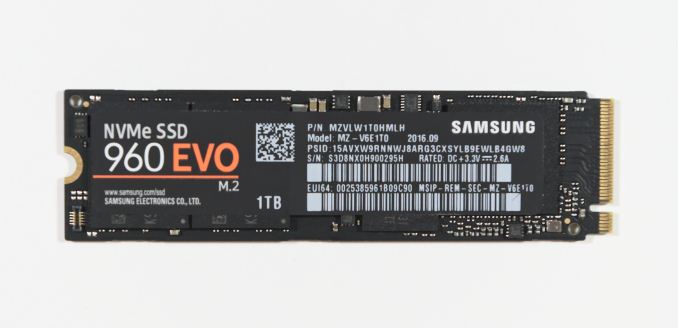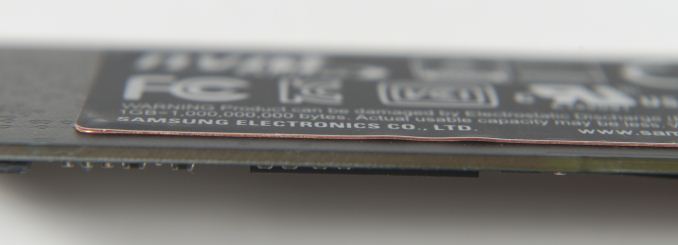The Samsung 960 EVO (1TB) Review
by Billy Tallis on November 15, 2016 10:00 AM EST
Last month the Samsung 960 Pro broke most of the performance records for a consumer SSD and often by a surprisingly large margin. But as impressive as it was to see the combination of high capacity and high performance in such a small package, the 2TB 960 Pro we reviewed is too expensive to be a realistic option for most enthusiasts.
Enter the Samsung 960 EVO. With the same powerful SSD controller used on the 960 Pro but much cheaper TLC 3D NAND, the 960 EVO is far more affordable but promises similar peak performance. Despite being Samsung's low-end M.2 PCIe option, the 960 EVO is aiming to outperform last year's 950 Pro and the current flagship PCIe SSDs from Samsung's competitors.
| Samsung 960 EVO Specifications Comparison | ||||||
| 960 EVO 1TB |
960 EVO 500GB | 960 EVO 250GB | 950 PRO 512GB |
950 PRO 256GB |
||
| Form Factor | single-sided M.2 2280 |
single-sided M.2 2280 |
||||
| Controller | Samsung Polaris | Samsung UBX | ||||
| Interface | PCIe 3.0 x4 | |||||
| NAND | Samsung 48-layer 256Gb TLC V-NAND |
Samsung 32-layer 128Gbit MLC V-NAND |
||||
| SLC Cache Size | 42GB | 22 GB | 13GB | N/A | ||
| Sequential Read | 3200 MB/s | 3200 MB/s | 3200 MB/s | 2500 MB/s | 2200 MB/s | |
| Sequential Write (SLC Cache) | 1900 MB/s | 1800 MB/s | 1500 MB/s | 1500 MB/s | 900 MB/s | |
| Sequential Write (sustained) | 1200 MB/s | 600 MB/s | 300 MB/s | N/A | N/A | |
| 4KB Random Read (QD32) | 380k IOPS | 330k IOPS | 330k IOPS | 300k IOPS | 270k IOPS | |
| 4KB Random Write (QD32) | 360k IOPS | 330k IOPS | 300k IOPS | 110k IOPS | 85k IOPS | |
| Power | 5.7W (average) |
5.4W (average) |
5.3W (average) |
7.0W (burst) 5.7W (average) 1.7W (idle) |
6.4W (burst) 5.1 (average) 1.7W (idle) |
|
| Endurance | 400TB | 200TB | 100TB | 400TB | 200TB | |
| Warranty | 3 Year | 5 Year | ||||
| Launch MSRP | $479.99 | $249.99 | $129.88 | $350 | $200 | |
The 960 EVO is not the first M.2 PCIe SSD to use TLC NAND. Samsung's OEM product line has the PM951 and PM961, using the same controllers as the 950 Pro and 960 Pro respectively. Intel has also shipped the 600p as their first 3D NAND SSD for the consumer market, but the Silicon Motion controller it uses is a far cry from the monster of a controller used in their flagship SSD 750.
As a more cost-focused product than the 960 Pro, the 960 EVO has a lower range of capacity options. With a maximum capacity of 1TB, the 960 EVO does not need to use the controller+DRAM package on package stacking that was necessary for the 2TB 960 Pro to be a single-sided M.2 module. As is normal for Samsung's EVO lines, the usable capacities are a bit smaller, with the 1TB EVO being 1000GB instead of 1024GB.
Some of the extra spare area reserved is used for the SLC write cache, which Samsung is now branding as 'Intelligent TurboWrite'. Where the 850 EVO's TurboWrite cache was 3-12GB depending on drive capacity, the 960 EVO has 4-6GB of guaranteed cache plus 9-36GB of dynamic cache when the drive has sufficient free space. Having a cache that is several times larger will greatly expand the range of workloads that can fit in the cache, and will help the 960 EVO make the best of its PCIe 3.0 x4 interface that is much faster than SATA.

Spot the copper-backed heat spreader label underneath
The 960 EVO includes all of the thermal management measures of the 960 Pro, including the copper-backed heat spreading label, a very power-efficient controller and a well-tuned thermal throttling implementation. TLC NAND has been shown to be, in general, slower and more power-hungry than MLC NAND so the 960 EVO is more susceptible to thermal throttling than the 960 Pro, but Samsung claims it is still less of a problem than it was for the 950 Pro, which means that virtually all real-world usage scenarios will not trigger throttling.
The warranty period for the 960 EVO is three years instead of the five enjoyed by the 850 EVO and both generations of MLC-based PCIe SSDs. The drive write endurance rating is also only half that of the 960 and 950 Pros, but 100TB for a 250GB drive is a sufficient amount.
For this review, Samsung provided an advance copy of their new NVMe driver version 2.0 to support the 960 Pro and 960 EVO as well as the 950 Pro. The 960 EVO was tested with Samsung's driver and the 960 Pro was also re-tested using this driver instead of Microsoft's driver built in to Windows. The results for the 950 Pro are still from version 1.0 of Samsung's NVMe driver. The next major release of Samsung's Magician software is still not quite ready, so exploration of encryption capabilities and other new features will have to wait. Samsung expects to release Magician 5 by the end of the month.
Samsung provided a 250GB 960 EVO and a 1TB 960 EVO for this review. The 250GB 960 EVO failed relatively early in the testing process, after completing a few of the IOmeter tests and while it was about 10% of the way through being filled to prepare for the next test. We are working with Samsung to determine the cause of the failure but due to the short time available we have not been able to reach a conclusion as of press time. These review units are technically preproduction samples and thus their failure rates are probably not indicative of the mass-market reliability. SSD deaths are nothing new at AnandTech, and in the past some of them have been our fault rather than due to defective goods. But regardless of what triggered this failure, there is a bright side: our testing usually doesn't tell us anything about the end-of-life behavior of SSDs. If our 250GB 960 EVO has indeed failed unrecoverably, it did so gracefully: the drive entered a read-only state during the fill process, which caused IOmeter to hang, but the data already written is still accessible and the drive still reports its SMART indicators and error codes. Aside from refusing to accept write or secure erase commands, the only symptom of the drive's failure is higher than normal idle power consumption.
For this review, the 1TB 960 EVO will be compared to the 2TB 960 Pro, last year's 950 Pro, and the current flagship NVMe drives from Intel and Toshiba (OCZ). For context, results from several 1TB SATA SSDs are also included. As always, our Bench tool can be used to compare against any other drive in our database of test results.
| AnandTech 2015 SSD Test System | |
| CPU | Intel Core i7-4770K running at 3.5GHz (Turbo & EIST enabled, C-states disabled) |
| Motherboard | ASUS Z97 Pro (BIOS 2701) |
| Chipset | Intel Z97 |
| Memory | Corsair Vengeance DDR3-1866 2x8GB (9-10-9-27 2T) |
| Graphics | Intel HD Graphics 4600 |
| Desktop Resolution | 1920 x 1200 |
| OS | Windows 8.1 x64 |
- Thanks to Intel for the Core i7-4770K CPU
- Thanks to ASUS for the Z97 Deluxe motherboard
- Thanks to Corsair for the Vengeance 16GB DDR3-1866 DRAM kit, RM750 power supply, Carbide 200R case, and Hydro H60 CPU cooler











87 Comments
View All Comments
Lolimaster - Wednesday, November 16, 2016 - link
The pci.e speed only matters if you move with huge chunks of data such as a high res video editing. For pretty much anything else it offers nothing over sata ssd's.Flying Aardvark - Wednesday, November 16, 2016 - link
"The pci.e speed only matters if you move with huge chunks of data such as a high res video editing. For pretty much anything else it offers nothing over sata ssd's."In which case, you'd want something that won't throttle under heavy load like the Intel 750. Otherwise, the 600P makes more sense in M.2 form (if it remains cheaper than the 960 EVO).
MajGenRelativity - Tuesday, November 15, 2016 - link
While I agree that both SSD's are fantastic performers (I bought a 500GB 850 Evo), I don't think that your statement on buying other products is right. Some users cannot afford either, and a cheaper SSD would provide a nice uplift.Samus - Wednesday, November 16, 2016 - link
The 860 EVO is selling around 20% more than the 850 EVO did at launch. Just because its NVMe doesn't mean Samsung can milk that much more out of it, the Intel 600p is NVMe and it cost almost half the price. And...Intel. I get that Samsung has improved tremendously in SSD reliability but many of us still have a sour butthole from the 840 TLC drives they never really fixed and honestly, we're comparing Porsches to Ferraris here. Nobody is going to notice the difference between these drives is day-to-day tasks.close - Wednesday, November 16, 2016 - link
"And...Intel"Can't say I really agree with this "default" view since I happened to see the end-of-life behavior for some Intel SSD's. This was some years ago (4-5) so the experience might not be relevant now but for multiple SSDs when they got close to their end of life I just got a warning popup in Windows to back up my data. That's it. I foolishly made the assumption that I can just image the SSD to speed up the process only to realize after the reboot that the SSD controller just killed itself on shutdown.
This isn't the kind of behavior you expect from any data storage medium. The explanation was that Intel was trying to avoid data loss from the drive just failing due to wear. And they chose to mitigate this by triggering data loss by design choice.
While the price and performance may be good I still have to think twice (or more) when considering Intel SSDs.
Phattio - Wednesday, November 16, 2016 - link
@close: thank you for posting this. good to know!Samus - Thursday, November 17, 2016 - link
Wow interesting I've come across dozens of X25-M's and lowest health I've seen was 77% in Intel SSD Toolbox and that was a 300GB SSD320 in an exchange server. The MDB was over 100GBAscaris - Friday, December 16, 2016 - link
Have to agree; that's completely unacceptable behavior. Samsung's 840 Pro (I think it was) went way, way beyond its rated life in the TechReport test (over 1 petabyte) before finally giving up the ghost. If the Intel in question bricked itself based on published ratings, it could have cut its useful life in half. I don't know if that's how it did it... a better way (that it could feasibly have also used) would be to issue the warning when most or all of the overprovisioned spare cells have been deployed to replace those that have worn out (which ought to be a sure sign that all of the cells are close to the edge because of wear leveling)... but if anything, it should go read-only, not brick itself.DrunkenDonkey - Tuesday, November 15, 2016 - link
Billy Tallis, can you make a QD1 comparison graph alongside the mix of 1,2,4? Because average end user pretty much only cares for 4k QD1, RR, the mixed stat is more niche and not indicative. Thanks.Flying Aardvark - Wednesday, November 16, 2016 - link
Seconded. Reads like an ad otherwise.